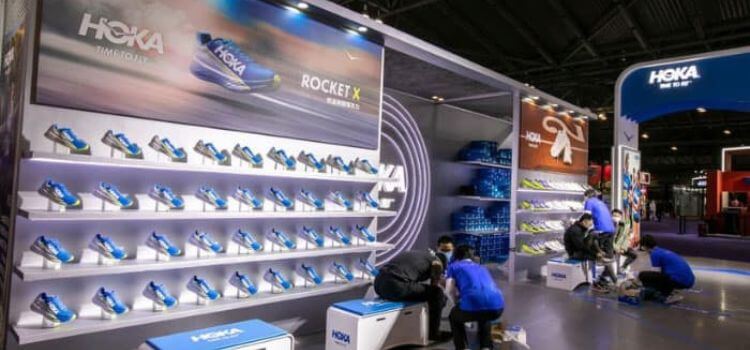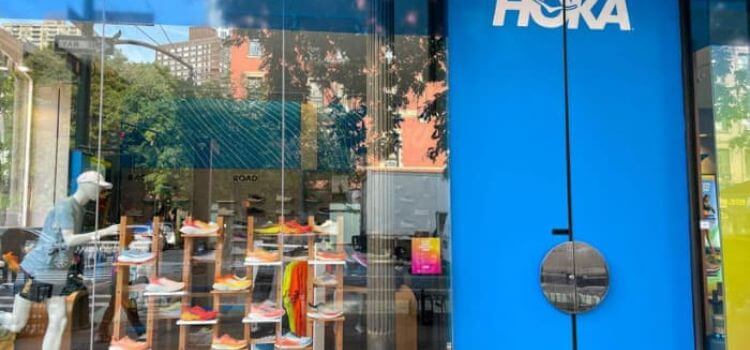Hoka shoes are primarily manufactured in Vietnam, with additional production in China. Many of their products come from these regions due to skilled labor and cost efficiency.
Hoka One One, often known simply as Hoka, is a well-regarded brand in the athletic footwear market, notable for its cushioned running shoes that blend comfort with performance. The brand has gained substantial popularity among both casual walkers and serious athletes.

Established in 2009 by two former Salomon employees, Hoka began with a mission to design shoes that could improve endurance race times by allowing runners to maintain a faster pace. They achieved this through innovative cushioning technology and midsole geometries. As a result, Hoka shoes have become synonymous with superior support and a distinctive oversized midsole—a unique feature that sets them apart in a crowded market. Their commitment to quality and innovative design keeps customers loyal and helps them stand out in the competitive world of athletic footwear.
The Birthplace Of Hoka One-One
Running enthusiasts often ask a fascinating question: Where are Hoka One One shoes made? The answer lies in the brand’s origins, deeply rooted in innovation and high performance. Known for its plush cushioning and unique design, Hoka One One has carved a niche in the running shoe industry. Let’s delve into the history and ethos behind this standout brand.
Origins And Brand History
The origins of Hoka One One trace back to the mountains of France. It was in 2009 when two trail runners, Nicolas Mermoud and Jean-Luc Diard, set out to create shoes that could handle the rigors of rugged mountain terrains. Their goal was simple yet ambitious: enhance endurance runners’ performance.
Their efforts led to the birth of a shoe that combined extra cushioning with a distinctive rocker design. This revolutionary approach quickly caught the attention of runners around the world. The nickname Hoka, derived from the Maori language meaning “to fly over the earth,” perfectly encapsulates the brand’s spirit.
Initial Production And Design Philosophy
When production first began, Hoka prioritized both comfort and efficiency. Early models were produced in limited quantities, with hands-on oversight to ensure quality. Overseeing the meticulous creation of each shoe, the founders ensured that their vision for a superior running sneaker was brought to life. This dedication resulted in a growing community of loyal Hoka fans who appreciated the brand’s distinctive style and functional benefits.
Performance and innovation remain at the heart of Hoka One One’s design philosophy. Their shoes are known for oversized midsoles yet surprisingly lightweight framework, providing a unique blend of cushioning and support. Running experts often highlight the intelligent engineering that goes into every pair, underscoring their niche in trail running and beyond.
Global Manufacturing Landscape
In our interconnected world, the Global Manufacturing Landscape of footwear stands as a complex and far-reaching web. Brands like Hoka have embraced this worldwide network to craft their renowned shoes. Let’s explore where these popular sneakers come to life.

Diversifying Production
As a brand striving for flexibility and resilience, Hoka diversifies its shoe production. This strategy minimizes risks like market fluctuation and political instability. It ensures a steady flow of their high-quality footwear.
- Reduces dependence on a single source
- Increases production capabilities
- Enhances global reach
Countries Involved In Manufacturing
Hoka shoes are products of a diverse set of countries renowned for their craftsmanship in shoemaking. Each region contributes its unique expertise to the final product.
| Country | Specialization |
| China | Mass Production & Advanced Techniques |
| Vietnam | Cost-Effective Labor & Quality Materials |
| Taiwan | Innovative Technology & Sustainability Practices |
Factory Insights And Standards
Diving into where Hoka shoes are born goes beyond geographical locations. It’s about the beating heart of craftsmanship: the factories. These manufacturing hubs adhere to rigorous standards, ensuring that every pair of Hoka shoes meets exceptional criteria.
Working Conditions And Ethics
Hoka is dedicated to ethical business. The brand ensures that its partner factories uphold top-tier conditions for their workers. They focus on fair labor practices, safe working environments, and respect for workers’ rights.
- Fair Wages: Employees receive fair compensation for their work.
- Safety Measures: Factories follow strict health and safety protocols.
- Respect: Work cultures promote dignity and respect.
Quality Control In Shoe Production
Quality is a signature of Hoka shoes. The brand implements strict quality control processes across all manufacturing stages. Shoes must pass multiple inspections before reaching consumers.
| Stage | Quality Check |
| Material Selection | Only the best materials are cut. |
| Assembly Line | Skilled workers craft each shoe with precision. |
| Final Inspection | Experts examine every detail before packaging. |
Impact Of Manufacturing Location On Consumers
The impact of manufacturing location on consumers goes beyond just production. It shapes perceptions, costs, and how easily people can buy products. For brands like Hoka, understanding this impact is crucial.
Consumer Perception Of Origins
Many shoppers care about where their shoes come from. A product’s origin can affect its perceived quality and brand image. Countries known for craftsmanship can command higher trust and respect. To many, Hoka shoes symbolize innovation and quality. Knowing they are produced in regions with strict quality control reassures consumers.
Location Influence On Cost And Accessibility
The country of manufacture plays a significant role in price and availability. Hoka shoes might vary in price across different regions due to manufacturing costs. Transportation, labor, materials, and tariffs all contribute to the final price of the tag.
- Labor costs can dictate how much a pair of shoes costs.
- Material availability in the production area affects production speed and stock levels.
- Trade agreements influence how easily shoes can cross borders.
This makes some regions have better deals or more limited releases than others.
In summary, where Hoka chooses to manufacture its shoes impacts not just the company but also consumers’ wallets and views.
Sustainability And Future Directions
Exploring the sustainability and future directions of Hoka shoes leads us to their manufacturing practices. Responsible production is at the forefront of Hoka’s mission. Let’s delve into how Hoka is stepping up its game.

Environmental Considerations
Hoka acknowledges the environmental impact of footwear manufacturing. The brand strives to minimize carbon footprints and waste production. Eco-friendly materials and processes are essential.
They focus on three core areas:
- Materials sourcing: Using recycled and bio-based fabrics
- Production efficiency: Reducing energy and water usage
- Waste management: Innovative recycling programs and reduction strategies
Innovations In Footwear Manufacturing
Hoka is not just about creating comfortable shoes. Innovation drives the brand forward. The company invests in cutting-edge technologies that could revolutionize the shoe industry.
| Technology | Description | Benefits |
| 3D Printing | Customization and precision in design | Less waste, quick prototyping |
| Biodegradable materials | Eco-friendly compounds and natural fibers | Less environmental impact post-use |
| Automated processes | Robotics and AI in production | Consistency, speed, and energy savings |
With these advancements, Hoka sets the stage for a sustainable future in athletic footwear.
Frequently Asked Questions For Where Are Hoka Shoes Manufactured
Do Hoka Shoes Come From China?
Hoka shoes are designed in the United States and manufactured in factories located in Vietnam and China.
Is Hoka Owned By Nike?
No, HOKA is not owned by Nike. Deckers Outdoor Corporation acquired HOKA in 2013.
What’s So Special About Hoka Shoes?
Hoka shoes feature a unique cushioned midsole design that provides exceptional comfort and support. Their lightweight construction enhances performance for runners, with a distinctive oversized outsole for increased stability.
Are Any Running Shoes Made In The USA?
Yes, some running shoes are made in the USA. Brands like New Balance and Brooks offer select models manufactured domestically.
Conclusion
Understanding the origins of our favorite footwear is critical. Hoka shoes exemplify quality, with production spanning from Asia to the Western Hemisphere. This global approach ensures diverse craftsmanship and access to premier materials. Choosing Hoka means investing in a brand committed to excellence, no matter where their shoes take shape.
Keep exploring, keep moving.
Related posts:
- Where To Recycle Athletic Shoes
- How To Choose Athletic Shoes
- What To Spray In Shoes For Athlete’s Foot
- Are Converse Considered Athletic Shoes
- How Long Do Athletic Shoes Last
- How To Clean White Athletic Shoes
- Are Athletic Works Shoes Non-Slip?
- What Company Developed The First Athletic Shoe?
- What Athletic Shoes are Made in the USA
- How To Stretch Athletic Shoes
